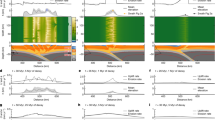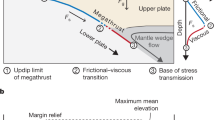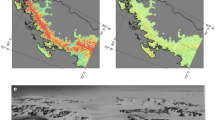Abstract
Recognition of the potential for strong dynamic coupling between atmospheric and tectonic processes has sparked intense cross-disciplinary investigation and debate on the question of whether tectonics have driven long-term climate change or vice versa. It has been proposed that climate change might have driven the uplift of mountain summits through an isostatic response to valley incision. Because isostasy acts to compensate mean elevations, the debate hinges on the question of whether climate change can significantly increase topographic relief or, more precisely, increase the volume of ‘missing mass’ between summits and ridges. Here we show that, in tectonically active mountain ranges, geomorphic constraints allow only a relatively small increase in topographic relief in response to climate change. Thus, although climate change may cause significant increases in denudation rates, potentially establishing an important feedback between surficial and crustal processes, neither fluvial nor glacial erosion is likely to induce significant isostatic peak uplift.
This is a preview of subscription content, access via your institution
Access options
Subscribe to this journal
Receive 51 print issues and online access
$199.00 per year
only $3.90 per issue
Buy this article
- Purchase on Springer Link
- Instant access to full article PDF
Prices may be subject to local taxes which are calculated during checkout





Similar content being viewed by others
References
Koons,P. O. Modeling the topographic evolution of collisional belts. Annu. Rev. Earth Planet. Sci. 23, 375–408 (1995).
Beaumont,C., Kamp,P., Hamilton,J. & Fullsack,P. The continental collision zone, South Island, New Zealand: Comparison of geodynamical models and observations. J. Geophys. Res. 101, 3333–3359 (1996).
Gilchrist,A. R., Summerfield,M. A. & Cockburn,H. A. P. Landscape dissection, isostatic uplift, and the morphologic development of orogens. Geology 22, 963–966 (1994).
Montgomery,D. R. Valley incision and the uplift of mountain peaks. J. Geophys. Res. 99, 13913–13921 (1994).
Molnar,P. & England,P. Late Cenozoic uplift of mountain ranges and global climate change: Chicken or egg? Nature 346, 29–34 (1990).
Small,E. E. & Anderson,R. S. Pleistocene relief production in Laramide mountain ranges, western United States. Geology 26, 123–126 (1998).
Stuwe,K., White,L. & Brown,R. The influence of eroding topography on steady-state isotherms. Application to fission track analysis. Earth Planet. Sci. Lett. 124, 63–74 (1994).
Mancktelow,N. S. & Grasemann,B. Time-dependent effects of heat advection and topography on cooling histories during erosion. Tectonophysics 270, 167–195 (1997).
Raymo,M. E. & Ruddiman,W. F. Tectonic forcing of late Cenozoic climate. Nature 359, 117–122 (1992).
Small,E. E. & Anderson,R. S. Geomorphically driven Late Cenozoic rock uplift in the Sierra Nevada, California. Science 270, 277–280 (1995).
Brozovic,N., Burbank,D. & Meigs,A. Climatic limits on landscape development in the Northwestern Himalaya. Science 276, 571–574 (1997).
Fielding,E. J., Isacks,B. L., Barazangi,M. & Duncan,C. How flat is Tibet? Geology 22, 163–167 (1994).
Masek,J. G., Isacks,B. L., Gubbels,T. L. & Fielding,E. J. Erosion and tectonics at the margins of continental plateaus. J. Geophys. Res. 99, 13941–13956 (1994).
Sklar,L. & Dietrich,W. E. in Rivers Over Rock: Fluvial Processes in Bedrock Channels (eds Tinkler, K. J. & Wohl, E. E.) 237–260 (AGU Press, Washington DC, 1998).
Montgomery,D. R. et al. Distribution of bedrock and alluvial channels in forested mountain drainage basins. Nature 381, 587–589 (1996).
Montgomery,D. R. & Buffington,J. M. Channel-reach morphology in mountain drainage basins. Geol. Soc. Am. Bull. 109, 596–611 (1997).
Montgomery,D. R. & Dietrich,W. E. Channel initiation and the problem of landscape scale. Science 255, 826–830 (1992).
Schmidt,K. M. & Montgomery,D. R. Limits to relief. Science 270, 617–620 (1995).
Burbank,D. W. et al. Bedrock incision, rock uplift and threshold hillslopes in the northwestern Himalayas. Nature 379, 505–510 (1996).
Heimsath,A. M., Dietrich,W. E., Nishizumi,K. & Finkel,R. C. The soil production function and landscape equilibrium. Nature 388, 358–361 (1997).
Hovius,N., Stark,C. P. & Allen,P. A. Sediment flux from a mountain belt derived by landslide mapping. Geology 25, 231–234 (1997).
Hovius,N., Stark,C. P., Chu,H. T. & Lin,J. C. Supply and removal of sediment in a landslide-dominated mountain belt: Central Rang, Taiwan. J. Geol. (in the press).
Tucker,G. E. & Bras,R. L. Hillslope processes, drainage density, and landscape morphology. Wat. Resour. Res. 34, 2751–2764 (1998).
Howard,A. D. in Rivers Over Rock: Fluvial Processes in Bedrock Channels (eds Tinkler, K. & Wohl, E. E.) 297–319 (AGU Press, Washington DC, 1998).
Rivers Over Rock: Fluvial Processes in Bedrock Channels (eds Tinkler, K. & Wohl, E. E.) 323 (AGU Press, Washington DC, 1998).
Whipple,K. X. & Tucker,G. E. Dynamics of bedrock channels in active orogens: Implications for height limits of mountain ranges, landscape response timescales, and research needs. J. Geophys. Res. 104, 17661–17674 (1999).
Hack,J. T. Studies of longitudinal steam profiles in Virginia and Maryland. US Geol. Surv. Prof. Pap. 294-B, 97 (1957).
Howard,A. D., Seidl,M. A. & Dietrich,W. E. Modeling fluvial erosion on regional to continental scales. J. Geophys. Res. 99, 13971–13986 (1994).
Tarboton,D. G., Bras,R. L. & Rodriguez-Iturbe,I. Scaling and elevation in river networks. Wat. Resour. Res. 25, 2037–2051 (1989).
Montgomery,D. R. & Foufoula-Georgiou,E. Channel network representation using digital elevation models. Wat. Resour. Res. 29, 1178–1191 (1993).
Willgoose,G. A physical explanation for an observed area-slope-elevation relationship for catchments with declining relief. Wat. Resour. Res. 30, 151–159 (1994).
Snyder,N. P., Whipple,K. X., Tucker,G. E. & Merritts,D. J. Landscape response to tectonic forcing: DEM analysis of stream profiles in the Mendocino triple junction region, northern California. Geol. Soc. Am. Bull. (in the press).
Hallet,B., Hunter,L. & Bogen,J. Rates of erosion and sediment evacuation by glaciers: a review of field data and their implications. Glob. Planet. Change 12, 213–235 (1996).
Paterson,W. S. B. The Physics of Glaciers (Pergamon, New York, 1994).
Oerlemans,J. Numerical experiments on large-scale glacial erosion. Z. Gletscherskunde Glazialgeol. 20, 107–126 (1984).
Harbor,J. M. Numerical modeling of the development of U-shaped valleys by glacial erosion. Geol. Soc. Am. Bull. 104, 1364–1375 (1992).
Andrews,J. T. Glacier power, mass balances, velocities and erosion potential. Z. Geomorphol. N. F. Suppl. Bd. 13, 1–17 (1972).
Small,E. E., Anderson,R. S., Repka,J. L. & Finkel,R. Erosion rates of alpine bedrock summit surfaces deduced from in situ 10Be and 26Al. Earth Planet. Sci. Lett. 150, 413–425 (1997).
Acknowledgements
This work was supported in part by the NSF (Continental Dynamics) and NASA (K.X.W.). We thank G. Tucker for discussions of relief evolution in active orogens, and D. Burbank, P. Molnar and E. Small for comments and suggestions.
Author information
Authors and Affiliations
Corresponding author
Rights and permissions
About this article
Cite this article
Whipple, K., Kirby, E. & Brocklehurst, S. Geomorphic limits to climate-induced increases in topographic relief. Nature 401, 39–43 (1999). https://doi.org/10.1038/43375
Received:
Accepted:
Issue Date:
DOI: https://doi.org/10.1038/43375
This article is cited by
-
Coupled Surface Process and Orographic Precipitation Model for the Landscape Evolution of the Himalayas
Journal of Earth Science (2024)
-
How does the digital service trade nonlinearly affect carbon emissions? Empirical evidence from G20 countries
Environmental Science and Pollution Research (2023)
-
Alpine rockwall erosion patterns follow elevation-dependent climate trajectories
Communications Earth & Environment (2022)
-
Topography of mountain belts controlled by rheology and surface processes
Nature (2022)
-
Lithologic Controls on Geomorphic Evolution of the Central Western Ghats: An Example from the Aghnashini Catchment, Karnataka, India
Journal of the Geological Society of India (2022)
Comments
By submitting a comment you agree to abide by our Terms and Community Guidelines. If you find something abusive or that does not comply with our terms or guidelines please flag it as inappropriate.



